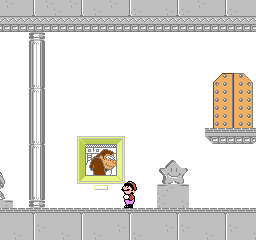Mario's Time Machine
Mario's Time Machine is an educational video game developed by The Software Toolworks and published by Mindscape. It was released for the Nintendo Entertainment System (NES), Super Nintendo Entertainment System (SNES), and MS-DOS in 1993. The game is part of the Mario series and is designed to teach players about historical events and figures.
Gameplay[edit | edit source]
In Mario's Time Machine, players control Mario, who must travel through time to return various artifacts to their correct points in history. The game begins with Bowser stealing artifacts from different time periods and placing them in his museum. Mario uses a time machine to visit different historical periods, where he must solve puzzles and answer questions related to the artifacts and their historical contexts.
The gameplay involves navigating through different time periods, interacting with historical figures, and collecting information to correctly place the artifacts. The game features a variety of historical settings, including Ancient Rome, Renaissance Italy, and Colonial America.
Development[edit | edit source]
Mario's Time Machine was developed by The Software Toolworks, a company known for creating educational software. The game was designed to combine entertainment with education, aiming to teach players about history in an engaging way. The development team worked closely with historians to ensure the accuracy of the historical information presented in the game.
Reception[edit | edit source]
Mario's Time Machine received mixed reviews upon release. Critics praised the game's educational value and the use of the popular Mario character to engage players. However, some reviewers felt that the gameplay was too simplistic and that the educational content was not as engaging as it could have been. Despite the mixed reviews, the game has maintained a cult following among fans of the Mario series and educational games.
Legacy[edit | edit source]
Mario's Time Machine is part of a series of educational games featuring Mario, including Mario Is Missing!. These games are notable for their attempts to use popular video game characters to teach educational content. While not as commercially successful as other games in the Mario series, Mario's Time Machine remains an interesting example of the intersection between entertainment and education in video games.
See also[edit | edit source]
References[edit | edit source]
External links[edit | edit source]
This article is a video game–related stub. You can help WikiMD by expanding it!
Search WikiMD
Ad.Tired of being Overweight? Try W8MD's physician weight loss program.
Semaglutide (Ozempic / Wegovy and Tirzepatide (Mounjaro / Zepbound) available.
Advertise on WikiMD
|
WikiMD's Wellness Encyclopedia |
| Let Food Be Thy Medicine Medicine Thy Food - Hippocrates |
Translate this page: - East Asian
中文,
日本,
한국어,
South Asian
हिन्दी,
தமிழ்,
తెలుగు,
Urdu,
ಕನ್ನಡ,
Southeast Asian
Indonesian,
Vietnamese,
Thai,
မြန်မာဘာသာ,
বাংলা
European
español,
Deutsch,
français,
Greek,
português do Brasil,
polski,
română,
русский,
Nederlands,
norsk,
svenska,
suomi,
Italian
Middle Eastern & African
عربى,
Turkish,
Persian,
Hebrew,
Afrikaans,
isiZulu,
Kiswahili,
Other
Bulgarian,
Hungarian,
Czech,
Swedish,
മലയാളം,
मराठी,
ਪੰਜਾਬੀ,
ગુજરાતી,
Portuguese,
Ukrainian
Medical Disclaimer: WikiMD is not a substitute for professional medical advice. The information on WikiMD is provided as an information resource only, may be incorrect, outdated or misleading, and is not to be used or relied on for any diagnostic or treatment purposes. Please consult your health care provider before making any healthcare decisions or for guidance about a specific medical condition. WikiMD expressly disclaims responsibility, and shall have no liability, for any damages, loss, injury, or liability whatsoever suffered as a result of your reliance on the information contained in this site. By visiting this site you agree to the foregoing terms and conditions, which may from time to time be changed or supplemented by WikiMD. If you do not agree to the foregoing terms and conditions, you should not enter or use this site. See full disclaimer.
Credits:Most images are courtesy of Wikimedia commons, and templates Wikipedia, licensed under CC BY SA or similar.
Contributors: Prab R. Tumpati, MD

